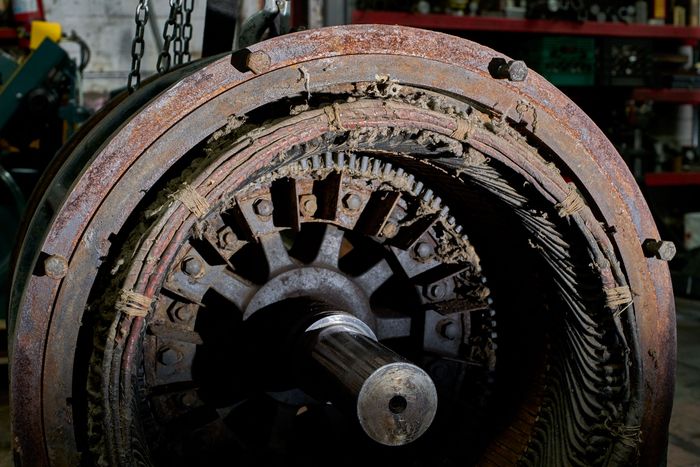
Don’t let the name fool you, the newest exhibition to open at the Whitney, “Kevin Beasley: A View of a Landscape” is not some easy, pastoral scenes. Taking over the entire eighth floor of the museum are three large-scale sculptures, a cotton gin motor in a soundproof glass box hooked up to a dozen microphones, and a nearly empty room where the motor’s mechanical noises can be heard. Just as the motor haunts this sparse room with its audio, the motor’s function haunts the exhibition. The cotton gin is a late 18th-century invention, originally powered by hand, horse, or water, that fueled the massive expansion of slavery in the American South.
New York–based Beasley is no stranger to sculptural and sonic experimentations, distinguished by elements of archivization and excavation. For the 2014 Whitney Biennial, he exhibited shining new sneakers trapped as what almost appear as fossils, with embedded microphones picking up ambient sounds, for instance, and in 2015, two assemblages also including shoes as well as other objects embedded with mics and speakers that reflected the ambient sounds back to museumgoers were part of Storylines at the Guggenheim Museum. His projects have included crushed cars (it’s worth noting that Beasley briefly studied automotive design), colliding football helmets, stained ties, seashell-filled golf bags, and other sculptures hewn from studio detritus and found objects. “A View of a Landscape,” however, is the 33-year-old’s first museum solo show, and a project many years in the making.
Six years ago, while still in graduate school at Yale, Virginia-born Beasley acquired the cotton gin motor today on view at the Whitney. It had been in use in Maplesville, Alabama, until 1973. “I knew it would be in my life for a really long time, so I brainstormed ideas about it as it sat in storage,” he recalls, adding that he also needed to wait until he had a big enough studio to really put the motor to use.
Simply displaying the motor as a ready-made could’ve been interesting, but it wasn’t enough for the artist. Part of reconfiguring the motor, and introducing the sound element came out of a desire to create a space for “play” between the object and its output. “Play [is] where you can push the boundaries of what the sound can be and do and how the ready-made sculpture is perceived,” Beasley explains. “There is a lot of space for play.”
Beasley placed the motor — one ton, but still quite compact — in its own room, locked in a glass vitrine, lit from below. Unlike an object in a history museum that might be totally inert, just an artifact, the motor is rapidly spinning, but still it’s divorced from both its own sound and function. The motor, which normally would be attached to a cotton gin, a device used to separate cotton from its seeds after it’s harvested, is not attached to anything, apart from a dozen or so microphones that are recording the motor’s whirring inside the entirely soundproof box. The noise of the spinning turbine is then being broadcast in another room. Together, the two parts make the single sculpture “A View of a Landscape: A Cotton Gin Motor,” with the date listed on the wall text (2012–18) spanning the six years from when he bought it off eBay, to today.
This second room, just past a curtain, is dimly lit, with purple walls lined with acoustic paneling and a plush, footstep-dampening carpet. At the far end is a mixing board with blinking modular synthesizers, appearing like an altar, or the control panel for a spaceship. The system modifies the sound coming from the variety of microphones the motor speaks into, and also offers Beasley the possibility of coming in, unannounced, throughout the exhibition’s three-month run to change the interpretation of the motor’s intangible output. The sound system will also be incorporated into the four live performances that will be happening over the course of the exhibition, both by Beasley and by other artists and musicians he’s selected: Taja Cheek, Eli Keszler, and Jlin.
Including other artists in these performances underscores the social element of the sculpture. The amplified drone, what curator Christopher Y. Lew refers to as a “sonic landscape,” is ever-changing. The sound is distinct at each point in time and at every spot in the room. There is no universal experience of the piece, but there’s a shared space and presence. Milling around in the listening room, it’s interesting to watch where museumgoers look when there’s nothing to look at, and to hear how they speak or stay silent in the midst of this noise, a sort of mechanical sound bath. “I think I’m asking an entire public to consider their relationship to this work and its subject matter because I can’t do it alone,” explains Beasley.
While the motor, or, as Beasley puts it, the “spectacle of the motor,” gets the majority of the attention, he is quick to point out that it’s “only one element of a much larger set of questions.” When you first get off the elevator, you’re immediately confronted with three sculptures, The Reunion, Campus, and The Acquisition, each nearly 1,000 pounds of material — raw cotton, Yale sweaters, sullied underwear, pine cones, twigs, audio equipment, laptops, blackface clown masks — trapped within clear rectangles, or “slabs,” as the wall text puts it, and bound by gobs of resin, giving them an uneven painterly surface. The eight-foot by ten-foot sculptures encapsulate, according to Beasley, “the materials and context that surround the understanding of the motor.” They create a dialogue with the motor of harvested material — personal, historical, technological, and natural. “My relationship to this object as an artist is reconciled within the sculptures,” he says.
There’s so much cotton in the show, confronting viewers with the raw material whose cultivation and use was the source of so much violence. “Some people will be experiencing masses of ginned raw cotton for the first time, and I’m curious as to how that will have an impact,” says Beasley. His own first encounter with raw cotton was a bit of a reckoning. “Experiencing a cotton field in Virginia on my family’s property was the event that led me to drive down to Alabama and purchase a one-ton cotton-gin motor. It shook me, not because I didn’t understand the violent history of the United States, but because I was forced to answer what my own personal relationship was to that history, today.” The three sculptures, which are punctuated with pages cut from David Eltis and David Richardson’s 2015 Atlas of the Transatlantic Slave Trade and Civil War–era cotton trade maps, act as “quasi-documents,” countering institutional capital-H History with personal and collective narrative identity. As he puts it: “You can’t talk about the impact of generational trauma with only textbooks.”
The works feel especially interconnected in the installation. “In many respects, it’s almost like the exhibition is one total artwork,” Lew says. It may be centered on this “performing object,” but it’s the relationship between the exhibition’s different elements that allows it to abstract and recontextualize the specific histories and geographies it’s referencing. Beasley describes his aim as offering “generative ways of thinking about race, labor, class, and ancestry, through an artistic lens.”
The content of the exhibition makes it clear that it’s engaging with the history of the slave trade and its lasting impact on contemporary American society — this specific motor was in use through the civil-rights era, and the cotton gin is an invention still in use today. But the formal qualities of the sculptural works also put Beasley’s exhibition in conversation with the history of minimalism. The New Yorker compares it with Robert Morris’s 1961 piece Box With the Sound of Its Own Making. However, what narrative and identity the stark plywood forms and industrial cubes minimalism claim to refute and evacuate from themselves in favor of some “pure” concept or raw phenomenological presence are filled back in, quite literally, by Beasley, and by us, as we listen in the room of the inverted, two-part central sculpture. Perhaps more than recalling Morris, Beasley’s “A View of a Landscape: A Cotton Gin Motor” might bring to mind Paul Thek’s Technological Reliquaries, unnerving cubes that filled minimal forms with cast body parts, made just a few years after Morris’s box. The motor is a present relic, a found object, its purpose rerouted not to produce cleaned cotton, but a certain kind of music.



